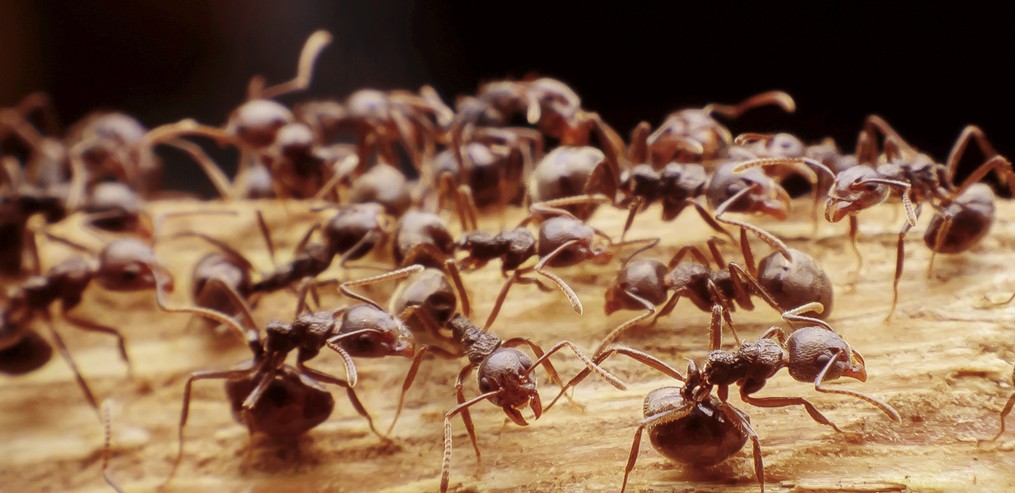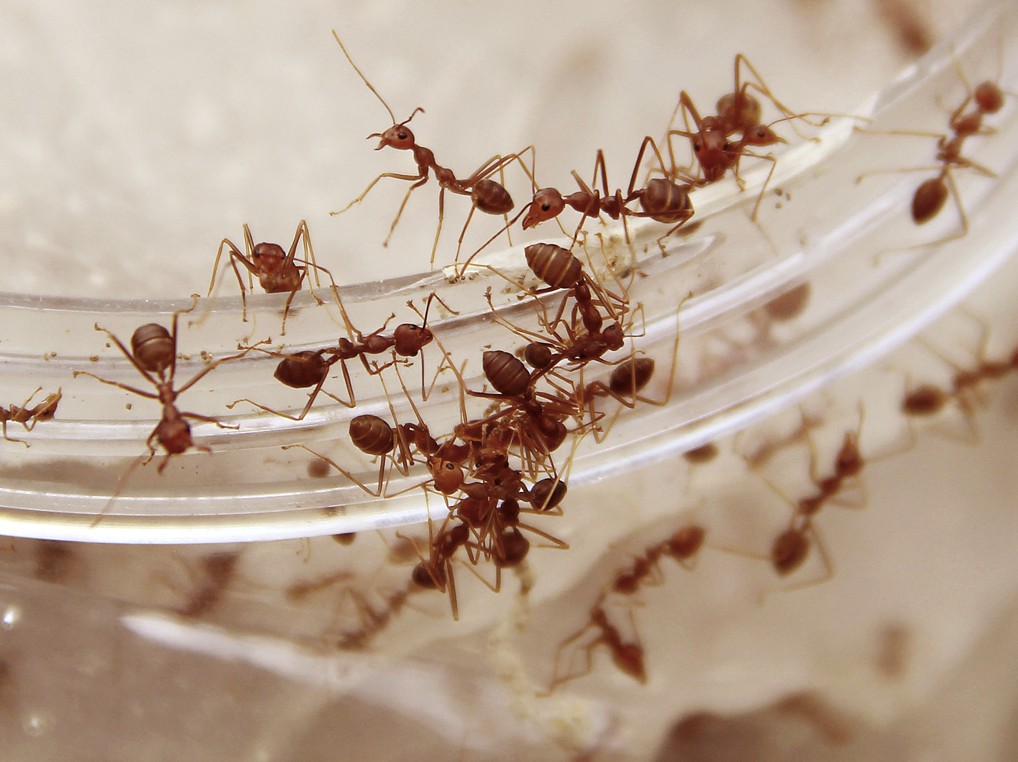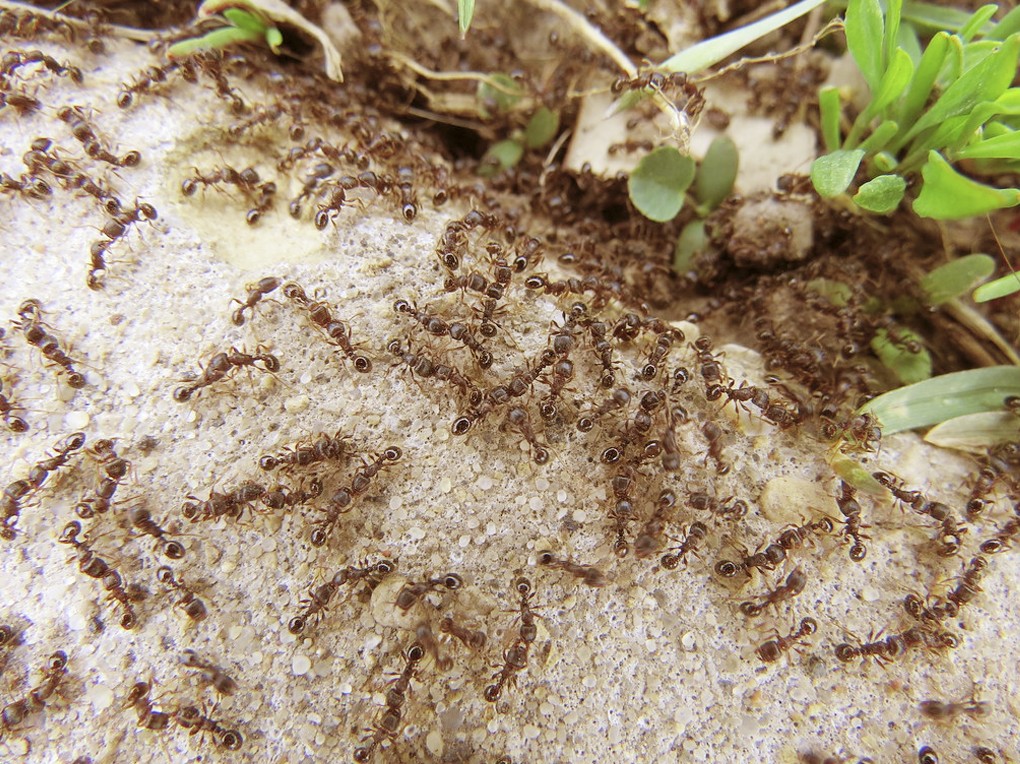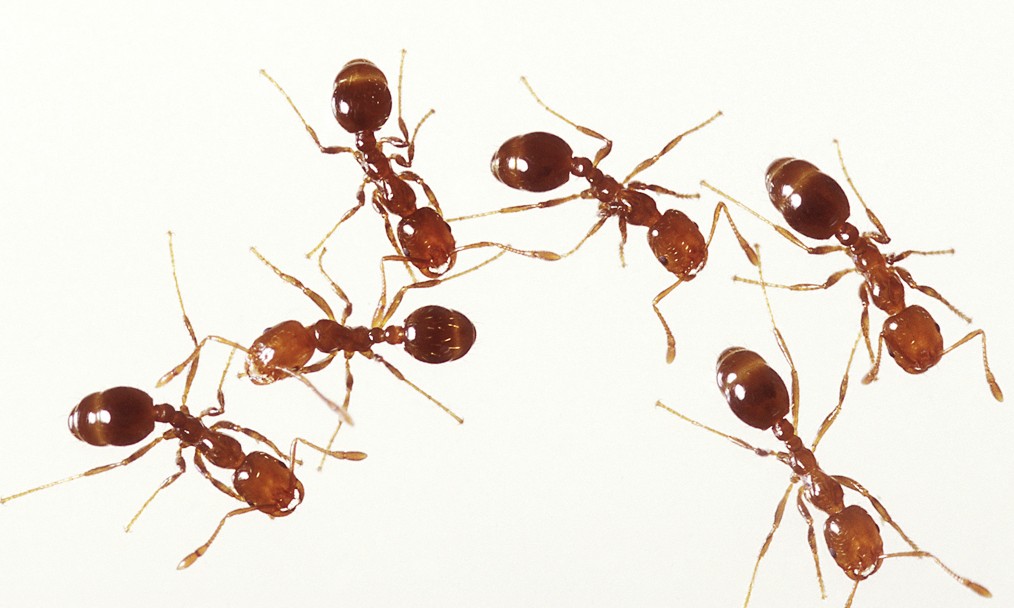Pavement Ants
What are Pavement Ants?
Pavement ants earned their name from their tendency to burrow under driveways, building slabs, sidewalks, etc. resulting dirt heap on top of pavements. The pavement ant is one of the most commonly encountered house infesting ants in the U.S.

Picture of Pavement ants
There are more than 12,000 different species of ants in the world and only a fraction of them cause problems for homeowners. These common species of ants range from destructive carpenter ants to relatively harmless pavement ants. Pavement ants generally make their homes in pavements and are small in size, which helps them to get inside tiny holes.
Identification of Pavement Ants

How do Pavement ants look like?
The pavement ants are about 1/8-1/16 inch long. They range from brown to black and have paler legs. They also have two antennae on their head. It has two spines on their back, grooves on their head, thorax, and two nodes on the petiole. If you see through a magnifying glass or microscope, you can see that pavement ants have tiny stiff hairs covering its entire body. Some of them have a stinger at the end of their abdominal.
Male pavement ants and the queen ants have wings, and they are twice the size. Spines are noticeable on winged females but are absent on the males. Flying pavement ants come out in spring, but if they get familiar to heat, then they can emerge any time of the year. Once flying ants mate, they shed their wings to lay eggs.
Behavior
Pavement ants often built their home under concrete cracks in sidewalks, driveways or rocks and logs. They create a dirt mound by pushing the dirt up through the top of its nest. The pavement ants are mostly found in the mid-western United States, Atlantic coastal regions, the southern United States, and the West Coast. They can also enter your house through the tiniest of cracks and make their homes indoors, in walls, beneath slabs, under floors, and in insulations. These ants move in small motion through specific trails, which contains pheromones for others to follow. Although we can see pavement ants during the day, they are most active at night.
What do Pavement Ants Eat?
Pavement ants eat much food consumed by humans and other animals. They will feed on a wide variety of foods such as sugar, meat, fruits, seeds, honey, grease, live or dead insects, etc. They prefer mostly greasy foods. A pavement ant enters your home in search of food and leaves trails for others when the source of food is located. They can become a nuisance if a large group of ants infest your house.
Habitat
Pavement ants build an underground nest, mostly in areas with very little vegetation. They make their nests outdoors under logs, stones, along cracks and curbs of pavements. Mostly they prefer living in ground-level masonry walls, but sometimes you can find them in vaults and insulation. These ants also carry soil up into the walls to form a nest. A colony of pavement ants can have one or multiple queens and numerous workers.
Reproduction
Pavement ants reproduce distinctively. The winged male ants mate with the female ants that come out in the spring season. The queen female winged ants are also known as swarmers, and they are solely responsible for the creation of new colonies. After mating, the queen ant search for an appropriate environment to lay eggs. Then the queen uses sand to protect the eggs from rocks or pavement. It takes two to three months for an ant to develop fully. This reproductive process generally takes place in spring, but some colonies which are living in warm indoors can reproduce any time of the year.
Pavement Ants Colonies
Pavement ants build their nest both indoors and outdoors to form their colony. Because of their small size, they quickly get inside your buildings or homes through tiny cracks, under the doors and windows, setting up their colonies. Although they do not destroy wood and house properties, they can be a nuisance when large numbers invade your house.
A typical colony of pavement ants consists of one or multiple queens, males and the female workers. The male ants and queen ants have wings, while the female ants don’t have wings. The job of the male pavement ants is to mate with the queen, and they have a shorter life span than other ants. As the queen ant grows to adulthood, it spends the rest of her life laying eggs. The ants also defend their colony by killing their enemy colonies in search of food or nesting space. They also protect the eggs and newborn from unstable moisture and temperature.
How to Inspect and Locate Pavement Ant’s Colony?
To locate pavement ant’s colony, it is necessary to put the bait near their trails. These ants are bound to find foods such as honey, sugar, or jam. Follow them when they are on their way back to the nest. You will see that all the ants tend to return to the same area. They always displace soil or dirt around sidewalks, driveways or curbs, which is noticeable along the cracks or joints. Look for colonies near the foundation of your house or garden. Look around sinks, baseboards, plumbing, toilets, and insulation of attics. You may observe pavement ants trailing during the day, but they do most of their work at night.
Are Pavement Ants Harmful?
Pavement ants are considered nuisance pests. They have a stinger, but they rarely sting people unless and until they are disturbed. These types of ants also bite, but it is generally too weak to penetrate human skin. Their bites are not venomous and do not require medical assistance. Sometimes the bite of a pavement ant can cause skin irritations or a rash for those who have sensitive skin.
If pavement ants get into your home, they can create little health concerns. They always crawl around trash and then to your food or dishes spreading harmful bacteria like Salmonella. It is a bacterium that grows in the intestinal areas of animals and humans, which can cause food poisoning, serious infections, vomiting, diarrhea, fever, etc.
What Causes Pavement Ants to Invade?
If pavement ants have built their nest near to your house, they will make their way to your foundation in search of foods or warm space to habitat. They make their way through cracks, tiny holes in your walls or basement floors. The cracks may allow them inside, but the food will keep them there. Once they are inside your house, they will most likely decide to stay until they are forced out. Pet food bowls, crumbs, kitchen trash, open food containers, etc. will keep them coming back and draw in other pests as well.
Removal: How to get rid of Pavement Ants?
While there are many products available in the market that promises to eliminate ants, most of them are ineffective, and they can make your problem worse. These ant control products like insecticide sprays do nothing to terminate the main problem of an ant infestation. Because of this, they come back again and again.
The most effective ways to solve this problem are as follows:
- Look around your house and eliminate food sources that might draw ants and other pests.
- Also, clean the pet food bowl every time after feeding them.
- Make sure that your indoor and outdoor trash cans have lids that can seal; this will keep the smell in and won’t let pests to feed.
- Pavement ants are attracted to moisture, to prevent them remove standing water around the home.
- Remove tree branches, and other plants cut away from the house. Ants use these branches and bushes to get into your home.
- Seal cracks and holes of the exterior of a house, where these tiny ants can squeeze through.
- Avoid keeping stones, landscapes, firewood, and other building materials next to the home’s foundation. Ants nesting under these are more likely to infest your house.
- Always clean up crumbs and spills from dining table and kitchen floor.
Pictures
Looking for more Pictures of Pavement Ants? Here are few more:





Facts
Here are some of the most surprising facts about pavement ants.
- There are more than 12000 species of ants in the world
- Some queen ants can live for several years and have millions of babies.
- An ant can lift 20 times its body weight.
- When ants fight, it is usually to death.
- Ants don’t have ears. They feel the vibration in the ground through their feet.
- While searching for food, ants leave a pheromone trail, so that they can come back to their nest.
- Ants don’t have lungs. They breathe through tiny holes in their body.
- Queen ants have wings, and they shed their wings when they lay eggs.
- If the queen of the colony dies, the ants also die within a few months. They don’t replace the queen ant.
- There are millions of ants in a colony, but only a queen ant can reproduce.
With the information, you will now be able to identify any pavement ants in your house or garden. Not only you have the idea of how these creatures work, but also know what steps should be taken depending on your situation. But sometimes battling ants can be a difficult job to do without proper tools. When the situation gets out of hand, don’t delay to call for professional help.
